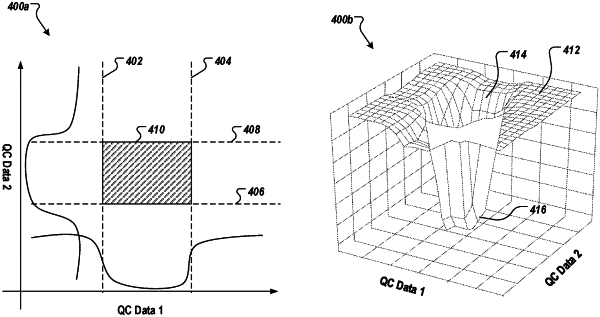| CPC H01L 21/67276 (2013.01) [G05B 19/41875 (2013.01); G05B 2219/32179 (2013.01); G06N 20/00 (2019.01)] | 17 Claims |

|
1. A computer-implemented method for detecting anomalies of products during lot production, wherein the products within a production lot are processed according to a sequence of steps that include manufacturing steps and one or more quality control steps interspersed among the manufacturing steps, the method comprising:
performing a first manufacturing step for products in a first production lot, the products comprising a first set of semiconductor wafers, the first manufacturing step at least partially forming one or more electronic circuits on each of the semiconductor wafers of the first set of semiconductor wafers;
executing one or more quality control steps after the first manufacturing step;
obtaining process quality inspection data from each of the one or more quality control steps for the first production lot;
obtaining product characteristics data for products in the first production lot after a final step in the sequence of steps;
training a Gaussian process regression model using the process quality inspection data and the product characteristics data from the first production lot;
generating a predictive distribution of the product characteristics data using the Gaussian process regression model that uses a bathtub kernel function, wherein the bathtub kernel function is defined as:
k(xi,xj)=∫φ(x,θ)φ(x,θ)dθ,
where φ(x, θ) is a bathtub function and θ represents the parameters θ=[α1, β1, γ1, α2, β2, γ2, δ], wherein the bathtub function can be expressed as
φ(x,θ)=α1·sig(β1tx+γ1)+α2·sig(β2tx+γ2)+δ
wherein αi determines the depth of the bathtub function, βi determines the steepness of the sides of the bathtub function, γi determines the width of the bathtub function, and δ determines the overall height of the bathtub function, and αi, βi, γi, and δ are real numbers, i.e., α1, β1, γ1, α2, β2, γ2, δϵR;
performing the first manufacturing step for products in a second production lot, the products comprising a second set of semiconductor wafers, the first manufacturing step at least partially forming one or more electronic circuits on each of the semiconductor wafers of the second set of semiconductor wafers;
after performing the first manufacturing step, obtaining process quality inspection data from a quality control step for the second production lot;
processing, using the predictive distribution of the product characteristics data, the process quality inspection data for the second production lot to detect any anomalous products in the second production lot;
if no anomalies are detected in the second production lot, updating the Gaussian process regression model using the process quality inspection data from the second production lot;
setting target values for one or more values in the process quality inspection data based on the predictive distribution of the product characteristic; and
adjusting settings of one or more manufacturing steps based on the target values.
|